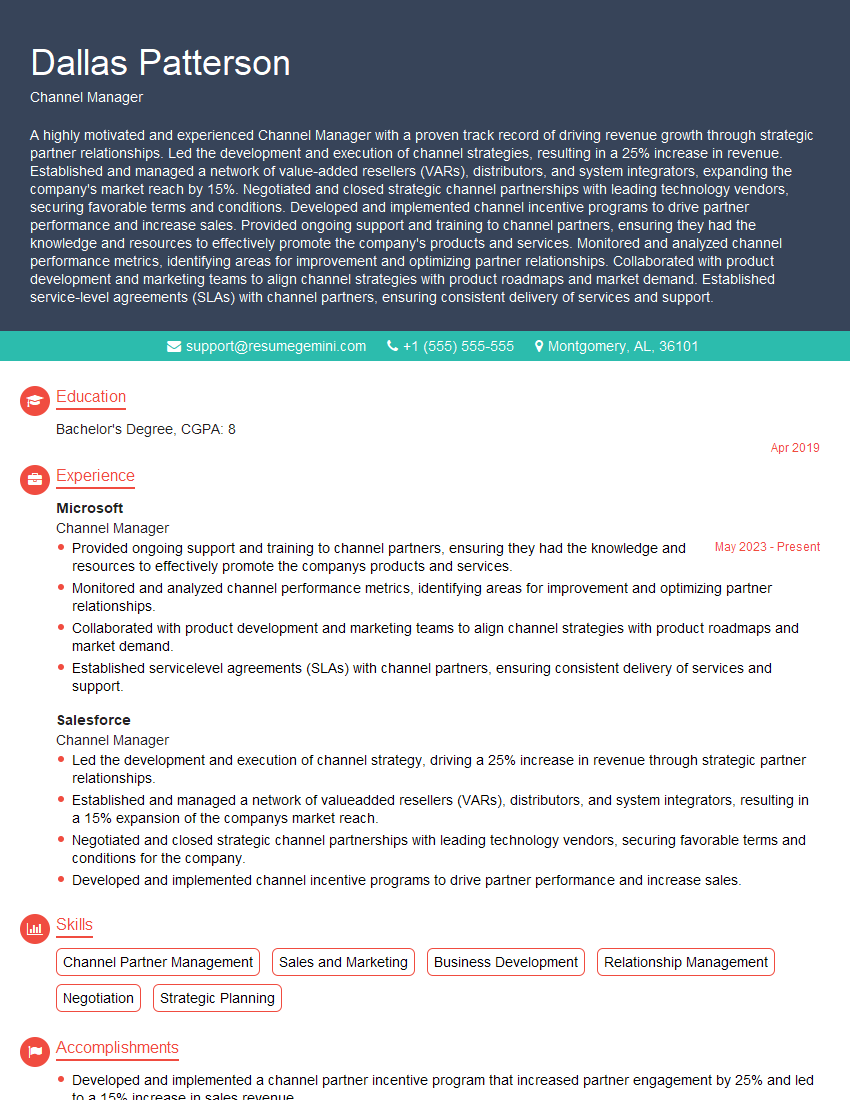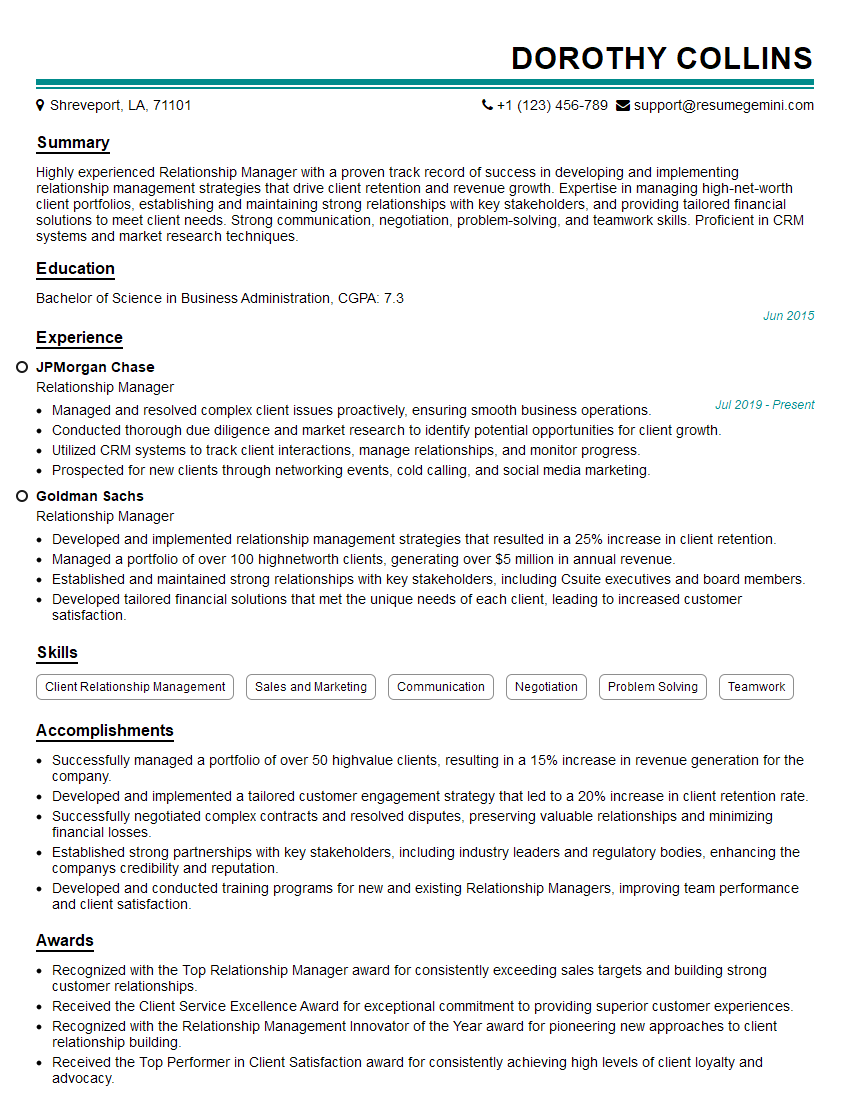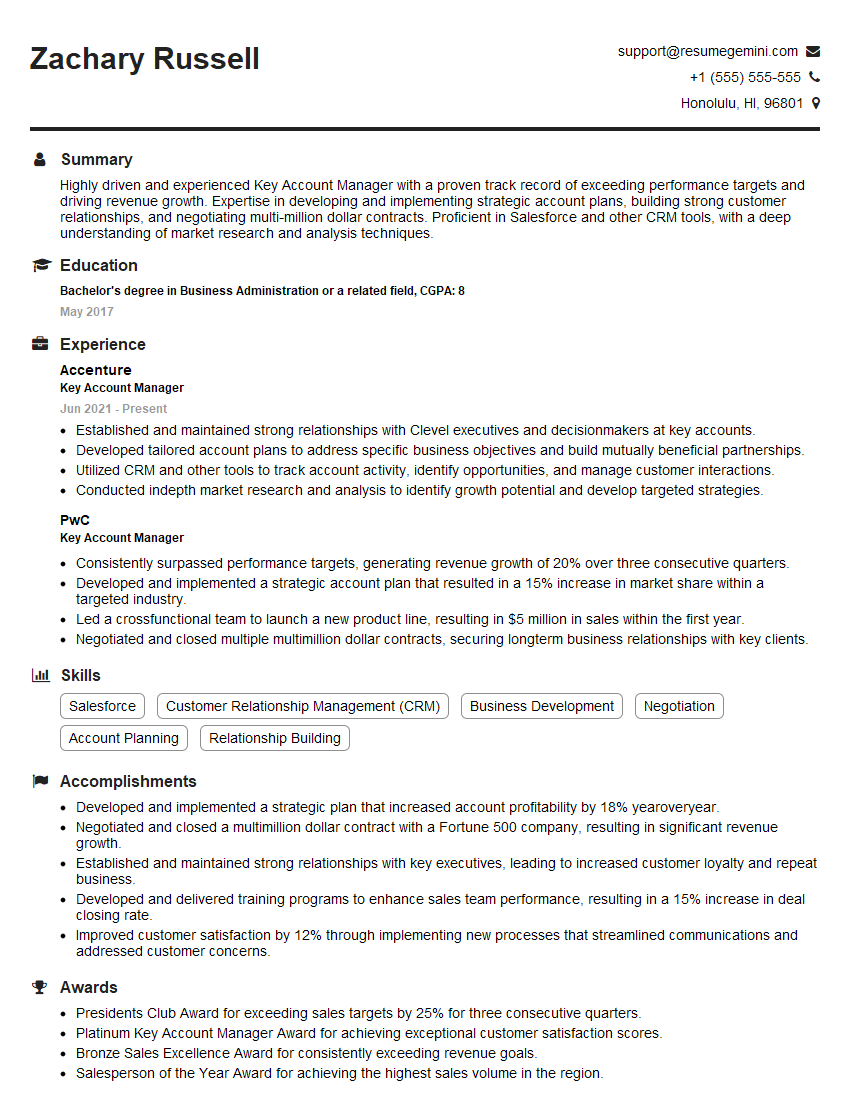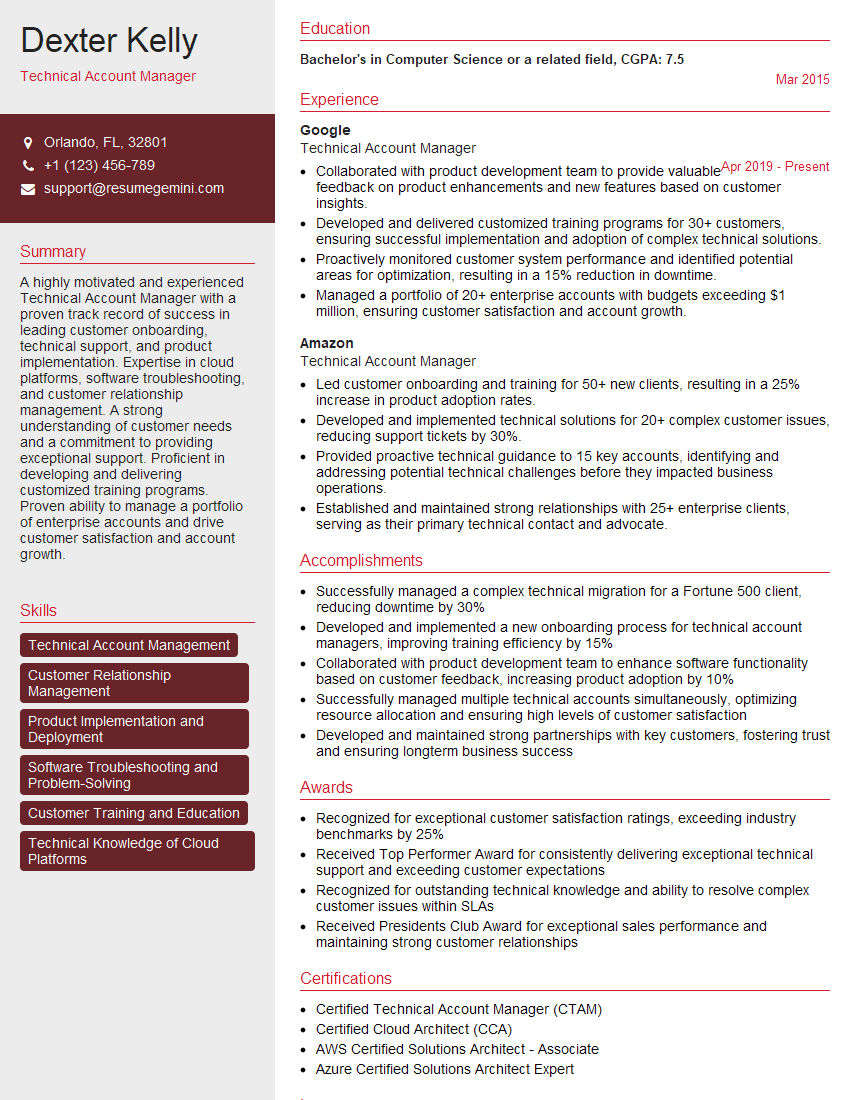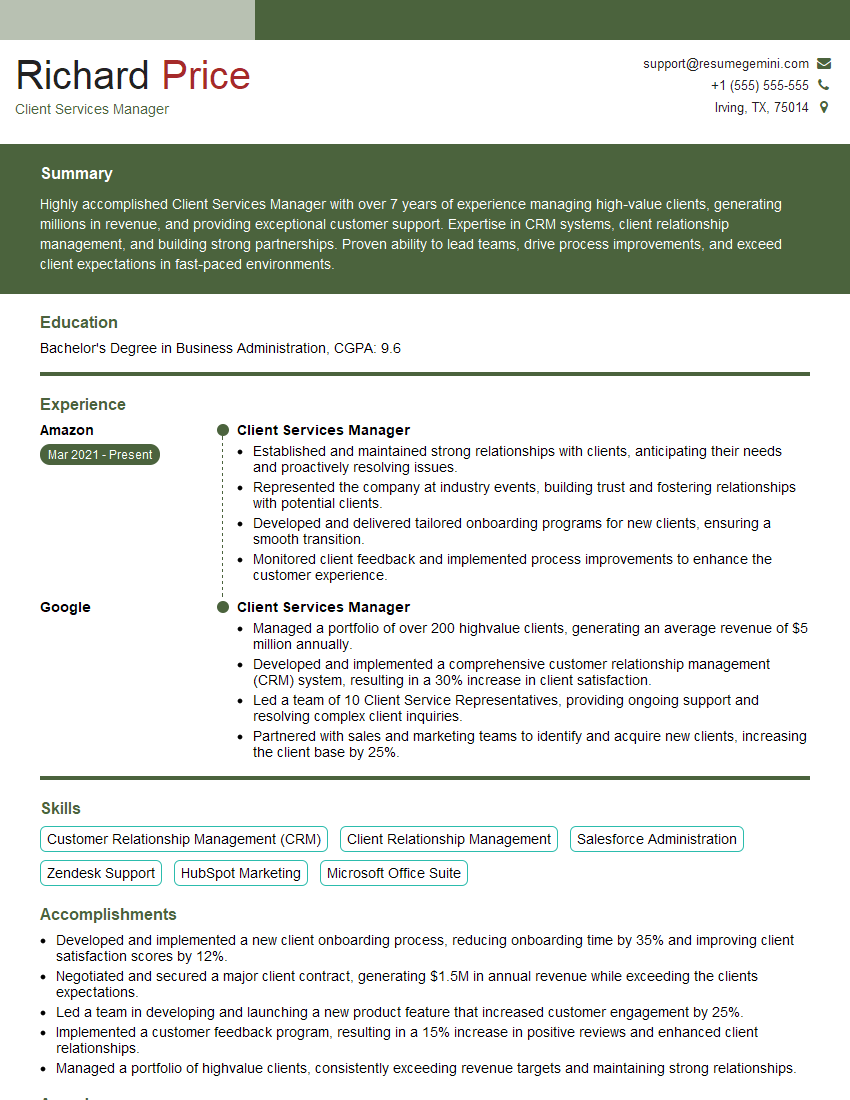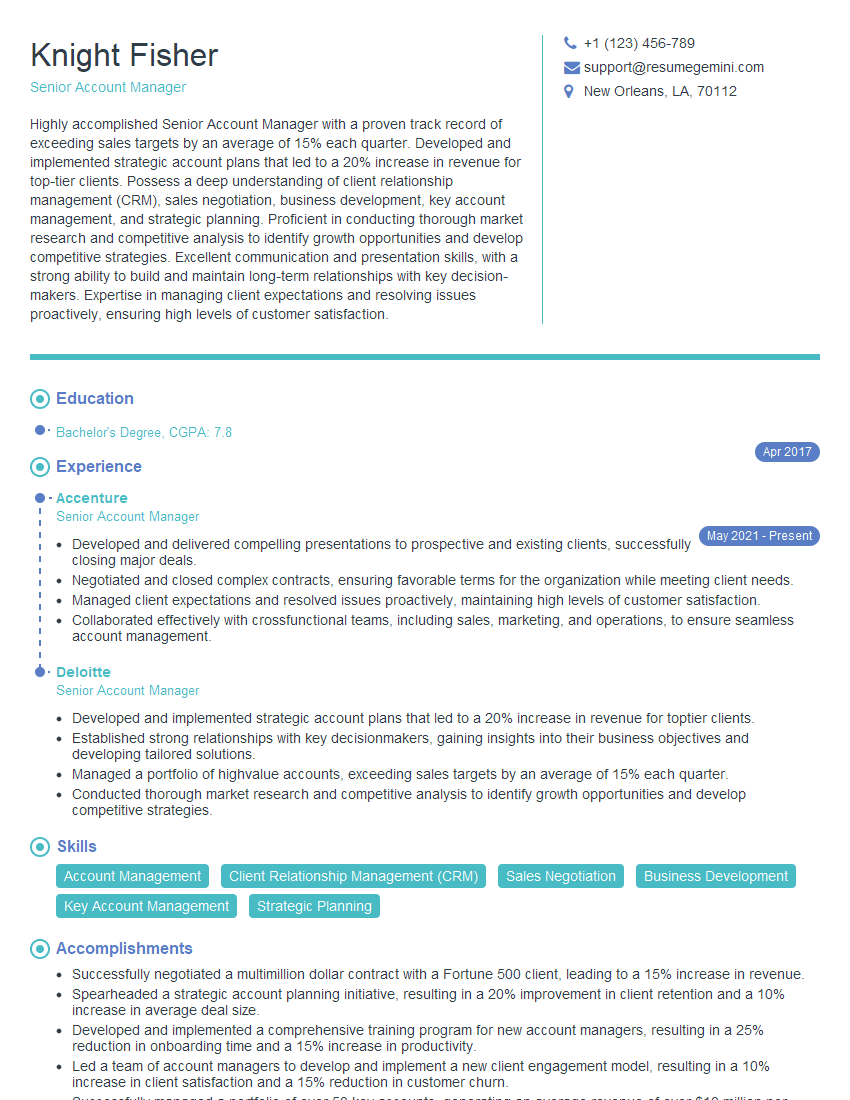The right preparation can turn an interview into an opportunity to showcase your expertise. This guide to Experience in working with a variety of clients interview questions is your ultimate resource, providing key insights and tips to help you ace your responses and stand out as a top candidate.
Questions Asked in Experience in working with a variety of clients Interview
Q 1. Describe your experience managing clients with differing communication styles.
Managing clients with diverse communication styles requires a high degree of adaptability and empathy. I approach this by first identifying each client’s preferred method of communication – some prefer concise emails, others lengthy phone calls, while some thrive on visual presentations. I actively listen during initial interactions to understand their communication preferences and adjust my style accordingly.
For instance, with a client who prefers quick email updates, I provide concise, bullet-pointed summaries. With a client who values detailed explanations, I offer more in-depth reports and scheduled calls for thorough discussions. This personalized approach ensures effective communication and builds trust.
- Active Listening: Paying close attention to verbal and non-verbal cues during initial meetings and throughout the project.
- Flexible Communication Channels: Utilizing a variety of methods like email, phone calls, video conferencing, and project management software, depending on the client’s preference.
- Clear and Concise Messaging: Tailoring the complexity and tone of my communication to match the client’s understanding and expectations.
Q 2. How do you tailor your approach to meet the unique needs of diverse clients?
Tailoring my approach to diverse clients involves understanding their unique needs, business goals, and cultural backgrounds. This begins with thorough discovery – asking open-ended questions to understand their current situation, challenges, and desired outcomes. I then create a customized plan that addresses their specific requirements, considering factors such as industry, size, and internal structure.
For example, a small startup might need more hands-on support and guidance, while a large corporation might require a more formal approach with detailed reporting and standardized processes. Understanding their internal workflows and decision-making processes is crucial for effective project management and collaboration.
- Client Discovery: Conducting thorough interviews and surveys to understand their business context and expectations.
- Customized Project Plans: Developing unique strategies based on client-specific needs and goals.
- Cultural Sensitivity: Recognizing and respecting cultural differences in communication styles and business practices.
Q 3. Explain a situation where you had to adapt your strategy to successfully manage a challenging client.
I once worked with a client who was incredibly demanding and prone to sudden changes in requirements. Initially, I tried to adhere strictly to the initial project plan, which resulted in constant disagreements and missed deadlines. I realized my strategy wasn’t working and needed to adapt.
I shifted to a more agile approach, implementing daily stand-up calls to discuss progress, address immediate concerns, and accommodate necessary changes. This allowed for greater flexibility and transparency. By proactively engaging the client in the decision-making process and demonstrating responsiveness, I built trust and eventually delivered a successful project. Open communication and a willingness to collaborate were key to turning the situation around.
Q 4. How do you prioritize tasks and manage multiple client projects simultaneously?
Prioritizing tasks and managing multiple client projects simultaneously requires a robust organizational system. I utilize project management software (like Asana or Trello) to track tasks, deadlines, and progress across all projects. I employ a prioritization framework, often using the Eisenhower Matrix (Urgent/Important), to allocate my time effectively. This allows me to focus on high-impact tasks that align with critical deadlines and client priorities.
Regular client check-ins are essential to ensure everyone is aligned and potential conflicts are addressed early. I also proactively communicate any potential delays or roadblocks to prevent escalation. Clear communication and proactive planning are crucial in managing multiple projects smoothly.
Q 5. Describe your process for building and maintaining strong client relationships.
Building and maintaining strong client relationships is built on trust, communication, and exceeding expectations. I start by establishing a clear understanding of the client’s needs and goals from the outset. Regular communication, both formal and informal, keeps the lines of communication open and facilitates a collaborative partnership. This includes providing regular updates on progress, promptly addressing concerns, and celebrating milestones together.
Proactive problem-solving and a commitment to delivering exceptional results are vital. Going the extra mile, even on small things, builds loyalty. Regular follow-up after project completion helps maintain the relationship and opens doors for future collaborations.
Q 6. How do you handle conflicts or disagreements with clients?
Handling conflicts requires a calm and professional approach. I begin by actively listening to the client’s concerns without interruption, ensuring I understand their perspective fully. Then, I calmly and clearly explain my perspective, focusing on finding common ground and solutions. It’s important to remain empathetic and avoid becoming defensive. If the conflict persists, I may suggest a structured mediation or involve relevant stakeholders to assist in resolving the issue.
Transparency and clear communication are paramount throughout the process. Documenting the conflict and the agreed-upon solutions helps prevent future misunderstandings.
Q 7. What metrics do you use to measure the success of your client relationships?
Measuring the success of client relationships goes beyond simply completing projects on time and within budget. I utilize several key metrics, including:
- Client Satisfaction: Regular feedback surveys and informal check-ins to gauge overall satisfaction.
- Project Success Rate: Tracking successful project completion and adherence to agreed-upon deliverables.
- Client Retention Rate: Measuring the percentage of clients who return for repeat business.
- Net Promoter Score (NPS): A metric to understand client willingness to recommend my services.
- Revenue Growth from Existing Clients: Measuring the expansion of services and projects with existing clients.
By analyzing these metrics, I can identify areas for improvement and continually enhance my client management practices.
Q 8. How do you identify and address potential risks or challenges in client projects?
Identifying and addressing potential risks in client projects is a proactive process that begins even before the project starts. It involves a thorough risk assessment, using a combination of methods.
- Project scoping and planning: We meticulously define project goals, deliverables, timelines, and resources. This initial phase allows us to identify potential roadblocks early on. For example, if a client requests a specific technology we lack expertise in, we’ll address this upfront, either by acquiring the needed skills or adjusting the project scope.
- Stakeholder analysis: Understanding the needs and expectations of all involved parties, including the client, internal teams, and third-party vendors, helps pinpoint potential conflicts or communication breakdowns. We document these clearly to mitigate future misunderstandings.
- Risk register: We create a documented risk register listing identified risks, their likelihood, their potential impact, and mitigation strategies. This helps us track progress and proactively address potential challenges. For instance, if a risk is the unavailability of a key resource, we’ll build in contingency plans, such as having a backup person or alternative approach.
- Regular monitoring and review: Continuous monitoring throughout the project lifecycle enables us to identify emerging risks and make timely adjustments. Weekly project meetings with the client and internal teams allow us to discuss challenges, update the risk register, and collaboratively develop solutions.
By implementing these strategies, we not only minimize project disruptions but also build stronger client relationships based on trust and transparency.
Q 9. Explain your experience working with clients in different industries or sectors.
My experience spans diverse sectors, including finance, healthcare, and education. Working with these different clients has honed my adaptability and problem-solving skills.
- Finance: In the finance sector, projects often involve stringent regulatory compliance and high security requirements. I’ve worked on projects implementing new financial management systems, requiring a deep understanding of financial regulations and data security best practices. The focus here is on accuracy, precision, and ensuring compliance.
- Healthcare: The healthcare industry demands a meticulous approach, prioritizing data privacy and patient confidentiality. I’ve been involved in projects related to electronic health record (EHR) systems, focusing on usability, data security, and compliance with HIPAA regulations. The emphasis is on user experience and data integrity.
- Education: Educational institutions need solutions that are user-friendly, engaging, and accessible to a broad range of users. I’ve worked on projects developing online learning platforms and management systems, focusing on intuitive design, accessibility features, and effective communication.
Each sector presents unique challenges, but the underlying principle remains consistent: understanding the client’s specific needs, their industry landscape, and their regulatory environment. This enables us to tailor our approach for optimal results.
Q 10. Describe a time you had to manage a client with unrealistic expectations.
I once worked with a client who had an extremely ambitious timeline for a complex software implementation, far shorter than what was realistically achievable given the project’s scope and complexity.
My approach involved a three-step process:
- Realistic Expectations Setting: I began by carefully explaining the technical challenges and the potential ramifications of rushing the project. I presented a detailed breakdown of the tasks, their dependencies, and the time required for each, using Gantt charts to visually illustrate the timeline. This helped the client understand the inherent limitations.
- Collaborative Re-scoping: Instead of simply rejecting their initial timeline, we worked together to re-scope the project. We identified the most critical features and prioritized them, postponing less crucial functionalities to later phases. This ensured we delivered a valuable core product within a reasonable time frame.
- Transparent Communication: I maintained open and frequent communication throughout the project, providing regular updates and highlighting any potential delays or roadblocks. This fostered trust and enabled proactive adjustments, preventing misunderstandings and fostering a collaborative approach to problem-solving. The key was to provide clear, consistent updates, avoiding jargon and focusing on what mattered most to the client.
While it was challenging, the collaborative approach led to a successful project, building trust and long-term client loyalty. We exceeded expectations on the core features, and laid the groundwork for future phases of the project.
Q 11. How do you leverage technology to improve client communication and collaboration?
Technology plays a crucial role in enhancing client communication and collaboration. We leverage several tools and platforms to achieve this:
- Project Management Software (e.g., Asana, Trello, Jira): These platforms enable centralized task management, progress tracking, and document sharing, promoting transparency and collaborative efforts. We use them to maintain a shared view of tasks, deadlines, and progress.
- Video Conferencing (e.g., Zoom, Microsoft Teams): Regular video calls facilitate direct communication, ensuring quick responses to questions and fostering a personal connection with clients. This is especially important for collaborative design sessions or when addressing complex issues.
- Instant Messaging (e.g., Slack): Instant messaging enables quick responses to queries, facilitating efficient communication and rapid problem-solving. It also acts as a repository for quick notes and updates.
- Cloud Storage (e.g., Google Drive, Dropbox): Cloud-based platforms facilitate the secure sharing of documents and project files, ensuring everyone has access to the latest information. They also track revisions and provide version control.
By strategically utilizing these technologies, we streamline communication, improve efficiency, and build a more collaborative and transparent working relationship with our clients.
Q 12. How do you ensure client satisfaction and loyalty?
Client satisfaction and loyalty are paramount. We achieve this through a combination of strategies:
- Exceeding Expectations: We consistently strive to go beyond the client’s initial requirements, proactively identifying opportunities for improvement and value addition. This might involve suggesting innovative solutions or optimizing processes to improve efficiency.
- Proactive Communication: We maintain open and transparent communication, providing regular updates and proactively addressing any potential concerns. We make sure to use easily understandable language and respond promptly to inquiries.
- Personalized Service: We tailor our approach to each client’s specific needs and preferences, understanding their unique business context and challenges. We build strong personal relationships.
- Feedback Mechanisms: We actively solicit feedback throughout the project lifecycle and utilize feedback to refine our processes and improve client satisfaction. This includes using formal surveys and informal check-ins.
- Post-Project Support: Even after project completion, we provide ongoing support and maintenance, ensuring the client’s continued success. This demonstrates our commitment to their long-term success.
By focusing on these elements, we build trust, foster strong relationships, and cultivate long-term client loyalty.
Q 13. Describe your approach to client onboarding and training.
Our client onboarding process is designed to be efficient and effective, ensuring a smooth transition and setting the stage for successful collaboration.
- Initial Consultation: We begin with a thorough consultation to understand the client’s needs, goals, and expectations. This involves discussing project requirements, timelines, and budget.
- Project Kick-Off Meeting: A formal kick-off meeting introduces the project team, outlines the project plan, and establishes communication protocols. We assign roles and responsibilities.
- Documentation and Training: We provide comprehensive documentation, including project guidelines, best practices, and technical manuals. We also offer tailored training sessions, focusing on the client’s specific needs and technical proficiency.
- Ongoing Support: We provide ongoing support and guidance throughout the project, answering questions and addressing concerns promptly. We conduct regular check-ins to monitor progress and address any challenges.
Our approach ensures a seamless onboarding experience, empowering clients to effectively utilize the solutions we deliver and fostering a collaborative environment.
Q 14. How do you handle client feedback, both positive and negative?
Handling client feedback, both positive and negative, is crucial for continuous improvement and client satisfaction.
- Positive Feedback: We acknowledge and appreciate positive feedback, using it to reinforce best practices and motivate the team. We also share positive feedback with the team involved, recognizing their contributions.
- Negative Feedback: Negative feedback is treated as an opportunity for learning and growth. We approach negative feedback with empathy and actively listen to understand the client’s perspective. We then work collaboratively to identify the root causes of dissatisfaction and develop solutions to address the issues. This may involve adjusting project plans, refining processes, or providing additional training.
- Documentation and Follow-up: All feedback, positive or negative, is carefully documented and analyzed to identify trends and areas for improvement. We follow up with clients to ensure the issues are resolved and their satisfaction is restored.
By effectively managing both positive and negative feedback, we continuously improve our service delivery and build stronger, more reliable client relationships.
Q 15. How do you proactively identify and address client needs before they become problems?
Proactively addressing client needs before they escalate into problems is crucial for building strong, lasting relationships. My approach is built on a foundation of proactive communication, diligent listening, and insightful analysis. I begin by establishing a clear understanding of the client’s business objectives and challenges during the initial onboarding phase. This involves in-depth discussions, reviewing existing documentation, and conducting thorough needs assessments. I then consistently monitor project progress, paying close attention to potential roadblocks or emerging concerns. This is often achieved through regular check-in meetings, progress reports, and utilizing project management tools that allow for real-time tracking and communication.
For example, during a recent project for a logistics company, I noticed a slight increase in delivery times flagged in their internal reporting. Although not yet a major problem, I proactively brought this to their attention, suggesting we analyze the underlying causes together. This led to the identification of a software update impacting routing optimization, which we addressed early, preventing significant future delays and potential client frustration.
Further, I regularly anticipate potential issues based on industry trends and best practices. By staying informed and understanding future challenges in the client’s industry, I can offer proactive solutions and adjust strategies accordingly. This proactive approach transforms potential problems into opportunities for improvement and strengthens the client relationship by showcasing my commitment to their success.
Career Expert Tips:
- Ace those interviews! Prepare effectively by reviewing the Top 50 Most Common Interview Questions on ResumeGemini.
- Navigate your job search with confidence! Explore a wide range of Career Tips on ResumeGemini. Learn about common challenges and recommendations to overcome them.
- Craft the perfect resume! Master the Art of Resume Writing with ResumeGemini’s guide. Showcase your unique qualifications and achievements effectively.
- Don’t miss out on holiday savings! Build your dream resume with ResumeGemini’s ATS optimized templates.
Q 16. Explain your process for gathering and analyzing client data to inform strategic decisions.
Gathering and analyzing client data is a systematic process involving several key steps. First, I identify the relevant data sources, which can include client surveys, feedback forms, project performance data, market research, and competitor analyses. The specific data sources will vary depending on the client and the nature of the project. The selection process requires careful consideration to ensure the data collected is reliable, relevant, and actionable.
Next, I employ a variety of methods for data collection, including structured interviews, questionnaires, and observations. Data is then cleaned and organized, ensuring accuracy and consistency. For instance, I might use spreadsheet software to consolidate data or a CRM system to track client interactions. I then use analytical techniques like statistical analysis or data visualization to reveal trends, patterns, and insights. For example, I might use a regression analysis to understand the correlation between marketing spend and customer acquisition. Finally, these insights are used to inform strategic decisions, whether it involves adjusting project plans, developing new service offerings, or improving internal processes. This data-driven approach minimizes assumptions, enhances decision-making, and increases project efficiency and client satisfaction.
Q 17. How do you measure client satisfaction and what actions do you take to improve it?
Measuring client satisfaction is an ongoing process, not a one-time event. I use a multi-faceted approach to gain a comprehensive understanding of client sentiment. This includes:
- Regular feedback surveys: These can be short, targeted surveys sent after project milestones or at the end of a project. I frequently employ Net Promoter Score (NPS) surveys to gauge overall client loyalty.
- Client interviews: More in-depth discussions allow for detailed feedback and the exploration of underlying issues.
- Performance monitoring: Tracking key metrics (e.g., project completion rates, client response times) provides objective insights into client experience.
Based on the feedback gathered, I take specific actions to improve client satisfaction. This might include refining project processes, providing additional training to team members, improving communication strategies, or developing new service offerings. For example, if feedback reveals a lack of clear communication, I’ll implement more frequent progress reports and create a more transparent communication channel.
Continuous monitoring and improvement are key. I regularly review client satisfaction data, adapting my approach to continually enhance the client experience and cultivate stronger relationships.
Q 18. Describe your experience with different client contract types and negotiations.
I have extensive experience working with various client contract types, including fixed-fee contracts, time-and-materials contracts, and value-based pricing contracts. Each contract type presents unique challenges and opportunities, and my approach to negotiations always prioritizes transparency and mutual benefit. For example, with fixed-fee contracts, I focus on thorough scope definition to avoid potential disputes later on. This involves detailed project specifications, clear deliverables, and defined acceptance criteria.
In time-and-materials contracts, the negotiation process focuses on establishing fair hourly rates and transparent tracking mechanisms for billable hours. For value-based pricing contracts, the negotiation revolves around defining key performance indicators (KPIs) that demonstrate the value delivered to the client, with payment tied to achieving those metrics.
Negotiations themselves are a collaborative process. I prepare thoroughly by researching the client’s business and industry, anticipating their needs and potential concerns. I approach negotiations with a win-win mentality, seeking agreements that are fair, equitable, and mutually beneficial. My goal is to create long-term partnerships based on trust and mutual understanding, making sure the contracts clearly outline responsibilities, expectations, and potential risks for both parties involved.
Q 19. How do you navigate complex client hierarchies and decision-making processes?
Navigating complex client hierarchies requires a strategic approach centered around understanding the organizational structure and key decision-makers. I begin by carefully mapping out the organizational chart, identifying key stakeholders and their respective roles and influence levels. This includes understanding reporting structures, decision-making processes, and potential power dynamics within the client organization.
Next, I tailor my communication and engagement strategies accordingly. For instance, I ensure that critical information is shared with the appropriate individuals, and I proactively seek input from relevant stakeholders at each stage of the project. Regular meetings with key decision-makers are essential for maintaining alignment and addressing potential concerns promptly. I also focus on building strong relationships with individuals at all levels, fostering open communication and collaboration.
In situations with multiple decision-makers, I facilitate consensus-building by presenting clear, concise information, proactively addressing concerns, and emphasizing the mutual benefits of proposed solutions. Open and honest communication is key to navigating any potential conflicts or differing opinions.
Q 20. How do you manage client expectations effectively?
Effective client expectation management is crucial for successful project delivery. It starts with clearly defining project scope, deliverables, timelines, and potential risks during the initial stages. This involves active listening, asking clarifying questions, and ensuring everyone is on the same page regarding project objectives.
I use various tools and techniques to manage expectations, including project management software for tracking progress, regular progress reports to keep clients informed, and proactive communication to address any emerging concerns. Whenever potential challenges arise, I communicate them transparently, outlining potential solutions and involving the client in the decision-making process. This collaborative approach fosters trust and minimizes misunderstandings.
For example, if a deadline is at risk, I promptly notify the client, explaining the reasons for the delay and presenting potential mitigation strategies. I always prioritize open and honest communication, aiming to maintain realistic expectations while ensuring project success.
Q 21. Describe a situation where you exceeded a client’s expectations.
During a project for a large retail client, they needed a new e-commerce platform launched within a tight deadline. The initial timeline seemed ambitious, and several technical challenges arose during the development phase. Instead of simply focusing on meeting the deadline, I proactively identified potential risks and developed a contingency plan. We implemented an agile development methodology, allowing for flexibility and iterative progress. We also prioritized critical features, ensuring the core functionality was delivered on time while deferring less crucial elements to a later phase.
Beyond meeting the initial deadline, we managed to integrate several unexpected features requested by the client during development, exceeding their expectations in terms of functionality and speed. The client was extremely pleased, not only with the timely launch but also with the added functionalities that improved their user experience significantly. This exceeded their expectations and ultimately led to a long-term partnership, demonstrating the value of proactive problem-solving and exceeding the basic requirements of the project.
Q 22. What is your experience with CRM systems and how have you used them to manage client relationships?
CRM systems are indispensable tools for managing client interactions. My experience spans several platforms, including Salesforce, HubSpot, and Zoho CRM. I’ve used them to centralize client data, track interactions, manage opportunities, and automate communication. For instance, in a previous role at a marketing agency, we used Salesforce to manage our entire client portfolio. This involved inputting client details, project timelines, communication logs, and campaign performance data. This allowed us to gain a holistic view of each client’s needs and progress, enabling proactive relationship management and improved service delivery. We also leveraged Salesforce’s automation features to send out timely updates, reminders, and personalized emails, improving client engagement and satisfaction.
- Centralized Data: All client information in one place, reducing data silos and improving access.
- Improved Communication: Streamlined communication through integrated email and task management features.
- Automated Processes: Reduced manual effort and improved efficiency through automated workflows (e.g., lead nurturing, reporting).
- Performance Tracking: Monitored client campaign performance and identified areas for improvement.
Q 23. How do you manage confidential client information?
Confidentiality is paramount. I adhere strictly to company data protection policies and relevant regulations like GDPR and CCPA. This includes using secure password management practices, accessing client data only on a need-to-know basis, and never sharing sensitive information with unauthorized individuals. For example, client financial information is stored in encrypted files, accessed only through secure internal systems, and only shared with those directly involved in financial management of the project. Physical documents are stored in locked cabinets. Furthermore, I consistently undergo security awareness training to stay up-to-date on best practices and emerging threats. Regular audits and reviews of security protocols are vital, and I actively participate in those.
Q 24. How do you handle client requests outside the scope of the agreed-upon project?
Requests outside the project scope are handled professionally and transparently. I begin by acknowledging the client’s needs and then explain that the request falls outside the current agreement. I detail the additional time, resources, and costs involved in fulfilling the request. I then offer options: either formally proposing a change order to include the new work within a revised contract, or suggesting alternative solutions that might be within the existing agreement. For instance, if a client suddenly requests a significant redesign of a website beyond the originally agreed-upon scope, I would clearly outline the additional development hours and associated costs. This prevents misunderstandings and maintains a positive client relationship based on mutual understanding and respect.
Q 25. How do you deal with difficult or demanding clients?
Dealing with difficult clients requires patience, empathy, and strong communication skills. My approach focuses on active listening, understanding their concerns, and finding mutually acceptable solutions. I start by validating their feelings, even if I don’t necessarily agree with their perspective. Then, I systematically address their concerns, offering specific solutions and timelines. For example, if a client is persistently unhappy with a project’s progress, I will first gather all relevant information to understand the root cause. If it’s a genuine issue, I’ll prioritize resolving it and clearly communicate the steps taken. If the issue stems from unrealistic expectations, I calmly and patiently explain the constraints and work towards a revised plan. It’s about finding a balance between meeting their needs and managing expectations realistically.
Q 26. Describe your experience with cross-functional collaboration to serve clients.
Cross-functional collaboration is crucial for delivering exceptional client service. In my previous role, we had projects involving designers, developers, marketers, and project managers all working together. I facilitated communication, ensuring everyone was aligned on client needs and project goals. For instance, during the launch of a new client campaign, I coordinated daily stand-up meetings to update each team on their progress, highlight any potential roadblocks, and ensure seamless collaboration. We used project management tools to track progress, assign tasks, and monitor deadlines, enabling effective teamwork and on-time delivery.
Q 27. How do you contribute to building and maintaining a positive client reputation for the company?
Building and maintaining a positive client reputation is a continuous effort. This involves not only delivering high-quality work but also exceeding expectations wherever possible. Proactive communication, prompt responses, and consistent follow-up are essential. I make sure to regularly check in with clients, seeking feedback and addressing any issues promptly. A positive client experience often leads to referrals and positive reviews, directly boosting the company’s reputation. I actively participate in client feedback surveys and use the insights to continuously improve our services and processes.
Q 28. What is your approach to continuously improving your client management skills?
Continuous improvement is key. I regularly attend industry conferences, webinars, and workshops to stay updated on the latest trends and best practices in client management. I also actively seek feedback from colleagues and clients, using it to identify areas for improvement in my own approach. I maintain a professional development plan, focusing on enhancing my communication, negotiation, and conflict-resolution skills. Regular reflection on past projects helps me identify what worked well and what could be improved next time, allowing me to continuously refine my strategies and techniques.
Key Topics to Learn for “Experience in Working with a Variety of Clients” Interview
- Understanding Client Needs: Learn to articulate how you effectively gather and analyze client requirements, considering diverse perspectives and communication styles.
- Adaptability and Flexibility: Showcase your ability to tailor your approach and communication to different client personalities and project needs. Provide examples of adjusting strategies for optimal results.
- Conflict Resolution and Negotiation: Discuss your experience in navigating disagreements, finding compromises, and maintaining positive client relationships even in challenging situations.
- Project Management Across Diverse Clients: Explain how you prioritize tasks, manage deadlines, and allocate resources effectively when working with multiple clients simultaneously.
- Communication Strategies: Highlight your proficiency in various communication methods (email, phone, in-person meetings) and your ability to adapt your communication style to different clients’ preferences.
- Client Relationship Management (CRM): Discuss your experience using CRM systems or similar tools to track client interactions, manage projects, and ensure client satisfaction.
- Measuring Client Success: Explain how you define and measure client success, and how you use this data to improve your service and demonstrate value.
Next Steps
Mastering your ability to articulate your experience with diverse clients is crucial for career advancement. It demonstrates versatility, adaptability, and strong interpersonal skills – highly sought-after qualities in today’s competitive job market. Building an ATS-friendly resume that highlights these skills is essential to maximizing your job prospects. ResumeGemini can help you create a powerful, impactful resume tailored to showcase your expertise in working with a variety of clients. Examples of resumes highlighting this experience are available to guide you. Use ResumeGemini to craft a resume that truly reflects your accomplishments and sets you apart.
Explore more articles
Users Rating of Our Blogs
Share Your Experience
We value your feedback! Please rate our content and share your thoughts (optional).
What Readers Say About Our Blog
Hello,
We found issues with your domain’s email setup that may be sending your messages to spam or blocking them completely. InboxShield Mini shows you how to fix it in minutes — no tech skills required.
Scan your domain now for details: https://inboxshield-mini.com/
— Adam @ InboxShield Mini
Reply STOP to unsubscribe
Hi, are you owner of interviewgemini.com? What if I told you I could help you find extra time in your schedule, reconnect with leads you didn’t even realize you missed, and bring in more “I want to work with you” conversations, without increasing your ad spend or hiring a full-time employee?
All with a flexible, budget-friendly service that could easily pay for itself. Sounds good?
Would it be nice to jump on a quick 10-minute call so I can show you exactly how we make this work?
Best,
Hapei
Marketing Director
Hey, I know you’re the owner of interviewgemini.com. I’ll be quick.
Fundraising for your business is tough and time-consuming. We make it easier by guaranteeing two private investor meetings each month, for six months. No demos, no pitch events – just direct introductions to active investors matched to your startup.
If youR17;re raising, this could help you build real momentum. Want me to send more info?
Hi, I represent an SEO company that specialises in getting you AI citations and higher rankings on Google. I’d like to offer you a 100% free SEO audit for your website. Would you be interested?
Hi, I represent an SEO company that specialises in getting you AI citations and higher rankings on Google. I’d like to offer you a 100% free SEO audit for your website. Would you be interested?
good





